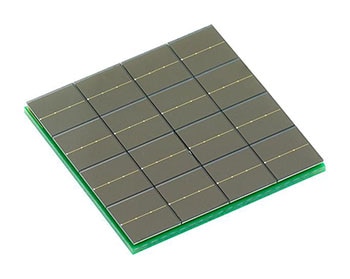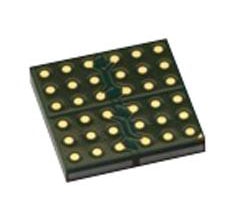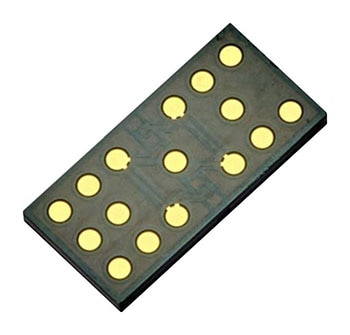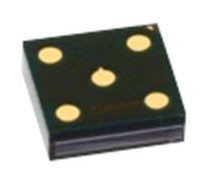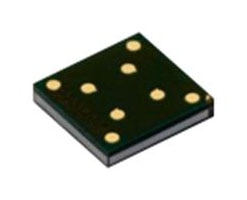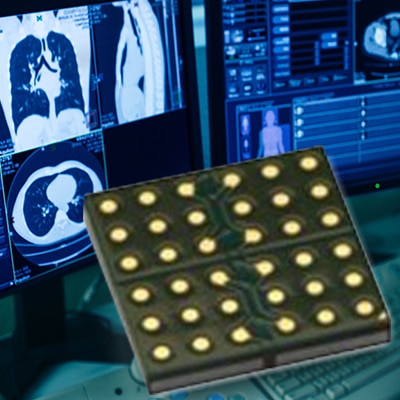 A silicon photomultiplier, or SiPM, is a solid-state photodetector that is used to detect and quantify light signals. They are particularly sensitive to low levels of light and are used in applications where precise and sensitive light detection is required. An SiPM is based on the principle of avalanche photodiodes, consisting of an array of small, interconnected silicon photodiodes (also known as pixels or microcells) that are operated in reverse bias. Each individual pixel can detect a single photon and when a photon is absorbed by a pixel, it triggers an avalanche-like multiplication of charge carriers, which results in a measurable electrical signal. The output of the SiPM signal is an electrical current proportional to the number of photons hitting the sensor. The result is a high-gain signal (>1 x 106) with fast reaction and recovery times.
A silicon photomultiplier, or SiPM, is a solid-state photodetector that is used to detect and quantify light signals. They are particularly sensitive to low levels of light and are used in applications where precise and sensitive light detection is required. An SiPM is based on the principle of avalanche photodiodes, consisting of an array of small, interconnected silicon photodiodes (also known as pixels or microcells) that are operated in reverse bias. Each individual pixel can detect a single photon and when a photon is absorbed by a pixel, it triggers an avalanche-like multiplication of charge carriers, which results in a measurable electrical signal. The output of the SiPM signal is an electrical current proportional to the number of photons hitting the sensor. The result is a high-gain signal (>1 x 106) with fast reaction and recovery times.
SiPMs are used in a variety of applications due to their exceptional sensitivity and versatility. They are commonly used in industries utilizing light detection and ranging (LiDAR) or radiation detection. SiPMs are also have applications in X-ray and gamma-ray detection, nuclear medicine, positron emission tomography (PET), safety, security, and Cherenkov detection applications.
Advantage of Silicon Photomultipliers
SiPMs have distinct advantages over traditional light detectors:
- SiPMs are highly sensitive and can detect individual photons, even in low-light conditions.
- The fast response time of SiPMs has made them invaluable for applications with an emphasis on precision timing.
- The compact size of SiPMs makes them ideal for space-constrained or portable applications.
- SiPMs are not influenced by magnetic fields, making them crucial for applications like magnetic resonance imaging (MRI).
- SiPMs have a wide spectral range, from ultraviolet to near-infrared.
- SiPMs can operate at low voltages, making them extremely energy efficient.
How do SiPMs Compare to Conventional Light Detectors (Photodiodes)?
SiPMs and conventional photodiodes are both photodetectors, but they differ in several key aspects. Photodiodes produce one electron and one hole for each incident photon, yielding a signal that can be overshadowed by intrinsic noise. Photodiodes have low gain, lack carrier multiplication, and provide limited signal amplification. When operating below the breakdown voltage, they exhibit a low excess noise factor. Their output signal is linearly proportional to the number of incident photons within a large intensity-range.
In contrast, when a photon strikes an SiPM, it can trigger an avalanche of carriers, allowing a single photo-generated carrier to generate a significant number of internal carriers, resulting in substantial signal amplification. Due to statistical carrier multiplication, SiPMs can amplify signals significantly, although this may introduce higher noise levels. If SiPMs operate beyond their breakdown voltage, they exhibit a self-sustaining avalanche effect, but a quenching resistor can reset the device within tens of nanoseconds after an avalanche event. An SiPM operates above its breakdown voltage, the voltage at which the electric field across the detector becomes strong enough to cause a sustained discharge or avalanche of charge carriers. This operational mode is referred to as Geiger mode. As a result, an SiPM produces a consistent output signal regardless of the photon count, making them ideal for photon-counting applications. They can also be arrayed to enhance performance, making them a preferred choice for sensitive and reliable photon detection in various applications.
What is the Difference Between an SiPM and a PMT?
Photomultiplier tubes (PMTs) are encased in fragile and bulky housing, with other limitations, including vulnerability to ambient light, sensitivity to magnetic fields, and the requirement for high voltage. These limit their adaptability in various applications. SiPMs present a more modern and versatile solution. They are resistant to ambient light and interference, housed in compact and robust enclosures suitable for handheld devices, and are unaffected by magnetic fields. They operate at a lower bias voltage and consume less power, in addition to offering higher light sensitivity and excellent timing performance. Furthermore, SiPMs support the construction of high granularity arrays, making them the preferred choice in applications that demand fast timing, high sensitivity, robustness, and compactness. A more detailed comparison of the two is shown in Table 1.
|
Characteristic |
Silicon Photomultiplier (SiPM) |
Photomultiplier Tube (PMT) |
|
Sensitivity |
Single photon |
Single photon |
|
Gain |
To |
To |
|
Large area |
Yes, scalable |
Yes |
|
Operation voltage |
30V to 50V |
800V to 2000V |
|
High-density arrays |
Yes |
No |
|
High granularity/ resolution |
Yes |
No |
|
Dark noise |
Fair |
Low |
|
Response time |
Very Fast |
Fast |
|
Uniformity |
Excellent |
Good |
|
Photon-counting resolution |
Excellent |
Good |
|
Temperature sensitivity |
Medium |
Low |
|
Immunity to ambient light |
Yes |
No |
|
Immunity to a magnetic field |
Yes |
No |
|
Compactness and lightweight |
Yes |
No |
Table 1: PMT and SiPM Comparison
How does a Silicon Photomultiplier work?
Photomultipliers
Shop our wide variety of Silicon Photomultipliers (SiPM) from Broadcom.
Don't forget to join our discussion.
SiPMs comprise arrays of avalanche photodiodes, often referred to as Single-Photon Avalanche Diodes (SPADs). They are designed to detect very low levels of light, down to a single photon. Depending on the light source and application, several hundred to thousands of SPADs can be connected parallel to form a SiPM array. Each SPAD in a SiPM includes an integrated series resistor that quenches the avalanche and resets the diode for the next incoming photon.
SPADs always produce the same output signal in Geiger-mode operation, regardless of the number of photons that initiate the avalanche. SPADs are binary – either ON or OFF. Multiple SPADs are often arranged in an array and connected in parallel (as shown in Figure 1), creating an SiPM array or silicon photomultiplier (SiPM) that can overcome this restriction and provide a more versatile output response to the number of detected photons.
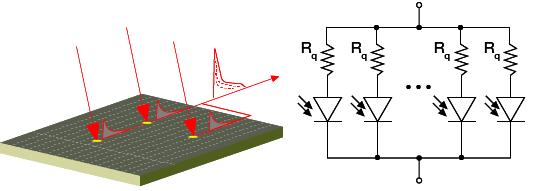
Figure 1: Schematic of a SPAD Arrangement and SiPM Signal Formation (Source: Broadcom)
What is the Basic Electrical Model of an SiPM?
Figure 2 depicts the basic electrical model of an SiPM electrical model. The key parameters of the model are Cd: capacitance of the single SPAD, Rq: quenching resistor, Cq: the parasitic capacitance of the quenching resistor, and Cg: the parasitic capacitance of the grid.
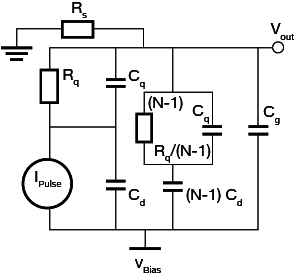
Figure 2: The Basic Model of an SiPM (Source: F. Corsi et al., Nuclear Instruments and Methods in Physics Research, 2007.)
What is Dark Noise (or Dark Rate) in an SiPM?
Dark noise, also known as dark count or dark rate, in a Silicon Photomultiplier (SiPM) refers to the unwanted or spurious electrical pulses generated by the SiPM in the absence of incident light. It represents the intrinsic noise level of the SiPM when no photons are striking the device. Dark noise makes it difficult to detect photons, especially in low light levels. It is primarily caused by thermal generation of carriers in the avalanche region can also be caused by defects or traps in the silicon material, which can capture and release charge carriers.
How to Select SiPMs for Specific Applications
Figure 3 depicts a decision tree used to determine the suitability of an SiPM for a specific application. This decision is based on several factors, including the wavelength of light to be detected, the type of light source (pulsed/continuous), the light intensity, and the frequency of light pulses. Depending on these factors and the specific application, the readout solution can be either a photon/pulse counting, a charge integration, or a combination of both.
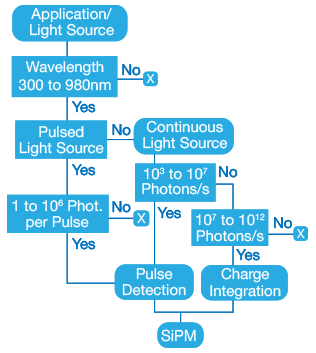
Figure 3: SiPM Application Decision Tree
SiPMs are well-suited for photodetection tasks, provided the application meets the requirements. These requirements may include geometrical considerations (photosensitive area, device volume), resistance to ambient light, the number of detection channels, granularity (number of channels per unit area), susceptibility to magnetic fields, or mechanical ruggedness.
Silicon Photomultipliers from Broadcom
Broadcom offers a diverse range of SiPMs tailored to various applications, including the new NIR30, designed for LiDAR applications and offer best-in-industry sensitivity at 905nm and 940nm.
Summing up: Detecting Light with Silicon Photomultipliers
In partnership with

Silicon photomultipliers have revolutionized light detection across various industries. Their high sensitivity, fast response times, and immunity to magnetic fields make them ubiquitous in applications ranging from clinical imaging to high-electricity physics. SiPMs are expected to continue playing a significant role in future innovations involving the detection of light at radiation. Broadcom offers a comprehensive range of reliable SiPMs that are tailored for a variety of application.
What new devices and applications do you think will be invented as photodetectors become smaller, more sensitive, and more accurate?
Please tell us in the Comments section below.


